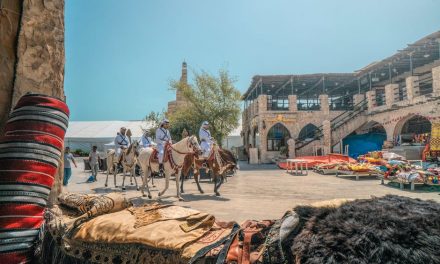Table of Contents
- Introduction
- The Role of Leadership in Arab Mythology: Examining the Traits and Actions of Legendary Figures
- Leadership Styles in Arab Mythology: Analyzing Different Approaches to Leading in Ancient Tales
- Lessons in Decision-Making from Arab Mythology: How Legendary Leaders Faced and Overcame Challenges
- Inspiring Leadership Lessons from Arab Mythology: Applying Ancient Wisdom to Modern Leadership Practices
- Q&A
- Conclusion
Unleash the power of ancient wisdom and become a legendary leader.
Introduction
“Leadership Lessons from Arab Mythology: From Legends to Leaders” explores the rich tapestry of Arab mythology and its profound insights into the realm of leadership. Drawing inspiration from ancient tales and legends, this book delves into the wisdom and guidance that can be gleaned from these mythical narratives. By examining the heroic figures and their journeys, readers are invited to uncover valuable lessons that can be applied to modern-day leadership challenges. Through this exploration, “Leadership Lessons from Arab Mythology” offers a unique perspective on leadership, blending ancient wisdom with contemporary insights to inspire and empower leaders in their quest for success.
The Role of Leadership in Arab Mythology: Examining the Traits and Actions of Legendary Figures

Leadership is a timeless concept that has been explored and celebrated in various cultures throughout history. Arab mythology, with its rich tapestry of legends and stories, offers a unique perspective on leadership and provides valuable lessons for leaders in the modern world. By examining the traits and actions of legendary figures from Arab mythology, we can gain insights into what it means to be an effective leader.
One of the most prominent figures in Arab mythology is Gilgamesh, the legendary king of Uruk. Gilgamesh is known for his strength, courage, and determination. These qualities are essential for any leader, as they inspire confidence and motivate others to follow. Gilgamesh’s quest for immortality also highlights the importance of having a vision and pursuing it relentlessly. A leader must have a clear goal and be willing to overcome obstacles in order to achieve it.
Another legendary figure from Arab mythology is Aladdin, the young hero who discovers a magical lamp. Aladdin’s story teaches us the importance of resourcefulness and adaptability. Despite his humble beginnings, Aladdin uses his wit and cunning to outsmart his enemies and ultimately become a powerful leader. This reminds us that leadership is not limited to those born into privilege, but can be attained through intelligence and resourcefulness.
In Arab mythology, there are also female figures who embody leadership qualities. One such figure is Scheherazade, the storyteller of One Thousand and One Nights. Scheherazade’s ability to captivate and influence others through her storytelling demonstrates the power of effective communication. A leader must be able to articulate their vision and inspire others to believe in it. Scheherazade’s stories also teach us the importance of empathy and understanding. By listening to the stories of others, a leader can gain valuable insights and build strong relationships.
In addition to these legendary figures, Arab mythology also offers lessons on the importance of integrity and justice in leadership. The story of Harun al-Rashid, the caliph of Baghdad, exemplifies these qualities. Harun al-Rashid is known for his fairness and wisdom in ruling his kingdom. He listens to the grievances of his people and ensures that justice is served. This reminds us that a leader must be guided by principles and act in the best interest of their followers.
Furthermore, Arab mythology emphasizes the importance of humility in leadership. The story of Sinbad the Sailor teaches us that even the most successful leaders must remain humble and grounded. Sinbad, despite his wealth and fame, never forgets his humble origins and remains grateful for his blessings. This humility allows him to connect with others and build strong relationships based on trust and respect.
In conclusion, Arab mythology offers a wealth of leadership lessons that are relevant in today’s world. By examining the traits and actions of legendary figures such as Gilgamesh, Aladdin, Scheherazade, Harun al-Rashid, and Sinbad, we can gain valuable insights into what it takes to be an effective leader. From strength and determination to resourcefulness and adaptability, these qualities are essential for inspiring and motivating others. Additionally, the importance of effective communication, empathy, integrity, justice, and humility cannot be overstated. By incorporating these lessons into our own leadership styles, we can become better leaders and make a positive impact on those we lead.
Leadership Styles in Arab Mythology: Analyzing Different Approaches to Leading in Ancient Tales
Leadership is a timeless concept that has been explored and studied in various cultures throughout history. One fascinating area to examine is Arab mythology, which offers a rich tapestry of ancient tales and legends that can provide valuable insights into different leadership styles. By analyzing the approaches to leading in these stories, we can gain a deeper understanding of the qualities and characteristics that make a great leader.
One prominent leadership style in Arab mythology is that of the wise and just ruler. This can be seen in the story of King Solomon, who is revered for his wisdom and ability to make fair and just decisions. In the tale of the two women who claimed to be the mother of a baby, Solomon’s wisdom allowed him to discern the true mother by suggesting to cut the baby in half. His ability to think critically and make difficult decisions showcases the importance of wisdom and fairness in leadership.
Another leadership style that emerges from Arab mythology is that of the courageous and fearless warrior. This can be seen in the story of Antar, a legendary Arab warrior known for his bravery and strength. Antar’s leadership style is characterized by his fearlessness in battle and his unwavering commitment to protecting his tribe. His ability to inspire and lead his fellow warriors is a testament to the power of courage and determination in leadership.
In contrast to the warrior leader, Arab mythology also presents the archetype of the wise advisor. This can be seen in the story of Jafar, the vizier of the caliph Harun al-Rashid. Jafar is known for his intelligence, wisdom, and ability to provide sound advice to the caliph. His leadership style is characterized by his ability to think strategically and offer guidance in times of uncertainty. Jafar’s role as a trusted advisor highlights the importance of wisdom and intellect in leadership.
Furthermore, Arab mythology also offers examples of leaders who possess a combination of different leadership styles. One such example is the character of Aladdin, who starts as a humble street urchin but eventually becomes a powerful and just ruler. Aladdin’s leadership style is characterized by his resourcefulness, bravery, and wisdom. His ability to adapt to different situations and make wise decisions showcases the importance of versatility and adaptability in leadership.
Overall, the stories and legends of Arab mythology provide a wealth of insights into different leadership styles. From the wise and just ruler to the courageous warrior and the wise advisor, these tales offer valuable lessons on the qualities and characteristics that make a great leader. By studying these ancient tales, we can gain a deeper understanding of leadership and apply these lessons to our own lives and organizations. Whether it is wisdom, courage, or strategic thinking, the leadership styles in Arab mythology offer a timeless guide for aspiring leaders.
Lessons in Decision-Making from Arab Mythology: How Legendary Leaders Faced and Overcame Challenges
Leadership Lessons from Arab Mythology: From Legends to Leaders
Arab mythology is rich with tales of legendary heroes and leaders who faced and overcame numerous challenges. These stories offer valuable lessons in decision-making that can be applied to modern leadership. By examining the experiences of these mythical figures, we can gain insights into how to navigate difficult situations and emerge as effective leaders.
One such lesson comes from the story of Antar, a legendary warrior known for his bravery and wisdom. Antar faced numerous challenges throughout his life, but it was his ability to make sound decisions in the face of adversity that set him apart. In one instance, he was faced with a difficult choice between personal gain and the greater good. Despite the potential for personal loss, Antar chose to prioritize the well-being of his people, demonstrating the importance of making decisions that align with one’s values and the needs of the community.
Another example of leadership in Arab mythology can be found in the story of Scheherazade, the legendary storyteller from One Thousand and One Nights. Scheherazade faced the challenge of an oppressive ruler who had a habit of marrying a new woman each day and executing her the following morning. To save herself and countless others, Scheherazade used her storytelling skills to captivate the ruler and keep him entertained for 1,001 nights. This tale teaches us the power of strategic thinking and the ability to use one’s strengths to overcome seemingly insurmountable obstacles.
In addition to these individual stories, Arab mythology also offers lessons in collective decision-making. The story of the Seven Sleepers, for example, tells of a group of young men who sought refuge in a cave to escape religious persecution. They made a collective decision to trust in God and sleep for hundreds of years, emerging to find a changed world. This story highlights the importance of unity and collaboration in decision-making, as well as the need to adapt and evolve in the face of changing circumstances.
These lessons from Arab mythology can be applied to modern leadership in various ways. Firstly, leaders can learn the importance of aligning their decisions with their values and the needs of their communities. By prioritizing the greater good over personal gain, leaders can build trust and inspire loyalty among their followers.
Secondly, leaders can learn the power of strategic thinking and leveraging their strengths to overcome challenges. Just as Scheherazade used her storytelling skills to save herself and others, leaders can use their unique abilities to find creative solutions to complex problems.
Lastly, leaders can learn the value of collective decision-making and the need for unity in the face of adversity. By fostering a culture of collaboration and encouraging diverse perspectives, leaders can make more informed decisions and adapt to changing circumstances.
In conclusion, Arab mythology offers valuable lessons in decision-making that can be applied to modern leadership. By examining the experiences of legendary figures such as Antar, Scheherazade, and the Seven Sleepers, leaders can gain insights into how to navigate difficult situations and emerge as effective leaders. Whether it is prioritizing the greater good, leveraging strengths, or fostering collaboration, these lessons from Arab mythology can help leaders make sound decisions and overcome challenges in their own leadership journeys.
Inspiring Leadership Lessons from Arab Mythology: Applying Ancient Wisdom to Modern Leadership Practices
Leadership Lessons from Arab Mythology: From Legends to Leaders
Arab mythology is a rich tapestry of ancient stories and legends that have been passed down through generations. These tales are not only entertaining, but they also contain valuable lessons that can be applied to modern leadership practices. By exploring the myths and legends of the Arab world, we can uncover inspiring leadership lessons that can guide us in our own leadership journeys.
One of the most prominent figures in Arab mythology is the legendary hero, Antar. Antar was a courageous and fearless warrior who overcame numerous challenges and obstacles to become a respected leader. His story teaches us the importance of perseverance and determination in the face of adversity. As leaders, we will inevitably face setbacks and obstacles, but it is our ability to persevere and stay focused on our goals that will ultimately lead to success.
Another important figure in Arab mythology is Scheherazade, the storyteller of One Thousand and One Nights. Scheherazade used her storytelling skills to captivate the attention of a king and save her own life. Her ability to engage and inspire through storytelling teaches us the power of effective communication in leadership. As leaders, we must be able to communicate our vision and goals in a way that resonates with our team members and inspires them to action.
In Arab mythology, the phoenix is a symbol of rebirth and renewal. The phoenix is said to rise from the ashes, stronger and more powerful than before. This myth teaches us the importance of resilience in leadership. As leaders, we will face failures and setbacks, but it is our ability to bounce back and learn from these experiences that will make us stronger and more effective leaders.
The story of Aladdin and the magic lamp is another well-known tale from Arab mythology. Aladdin’s journey from a humble street urchin to a powerful leader teaches us the importance of humility and integrity in leadership. Despite his newfound wealth and power, Aladdin remained true to his values and used his position to help others. As leaders, it is important to remember that our actions and decisions have a lasting impact on those around us, and it is our responsibility to lead with integrity and humility.
Arab mythology also features the story of Sinbad the Sailor, a legendary adventurer who traveled the world and faced numerous challenges. Sinbad’s story teaches us the importance of adaptability and flexibility in leadership. As leaders, we must be able to navigate through uncertain and changing environments, and adapt our strategies and approaches accordingly. By embracing change and being open to new ideas, we can lead our teams to success in an ever-evolving world.
In conclusion, Arab mythology offers a wealth of inspiring leadership lessons that can be applied to modern leadership practices. From the perseverance of Antar to the storytelling skills of Scheherazade, these ancient tales provide valuable insights into the qualities and behaviors of effective leaders. By embracing the wisdom of Arab mythology, we can become better leaders and guide our teams to success. So let us learn from these legends and apply their lessons to our own leadership journeys.
Q&A
1. What is “Leadership Lessons from Arab Mythology: From Legends to Leaders” about?
“Leadership Lessons from Arab Mythology: From Legends to Leaders” explores the ancient myths and legends of Arab culture and draws valuable leadership lessons from them.
2. Who is the author of “Leadership Lessons from Arab Mythology: From Legends to Leaders”?
The author of “Leadership Lessons from Arab Mythology: From Legends to Leaders” is Dr. Ali Alkhatib.
3. What can readers expect to learn from this book?
Readers can expect to learn about leadership qualities and strategies through the analysis of Arab mythological figures and their stories.
4. Is “Leadership Lessons from Arab Mythology: From Legends to Leaders” based on historical events?
No, the book is based on Arab mythology and the lessons derived from these mythical stories, rather than historical events.
Conclusion
In conclusion, “Leadership Lessons from Arab Mythology: From Legends to Leaders” offers valuable insights into leadership principles and strategies derived from Arab mythology. By examining the stories and characters from Arab folklore, the book provides a unique perspective on leadership qualities such as courage, wisdom, and resilience. It highlights the importance of storytelling and the power of myth in shaping leadership styles and inspiring others. Overall, this book serves as a valuable resource for individuals seeking to enhance their leadership skills by drawing inspiration from Arab mythology.




